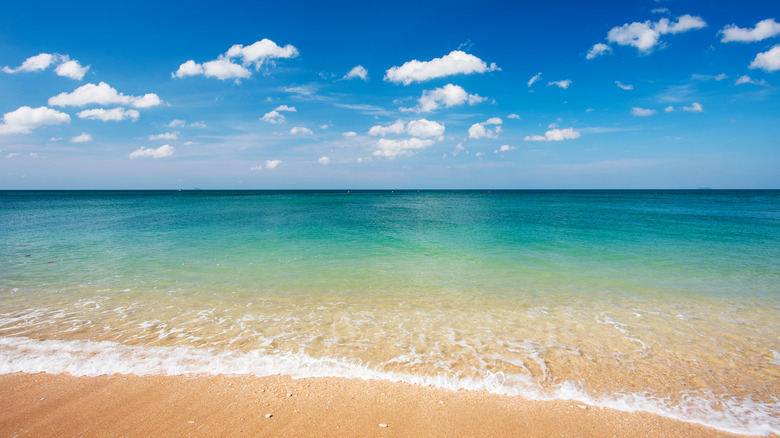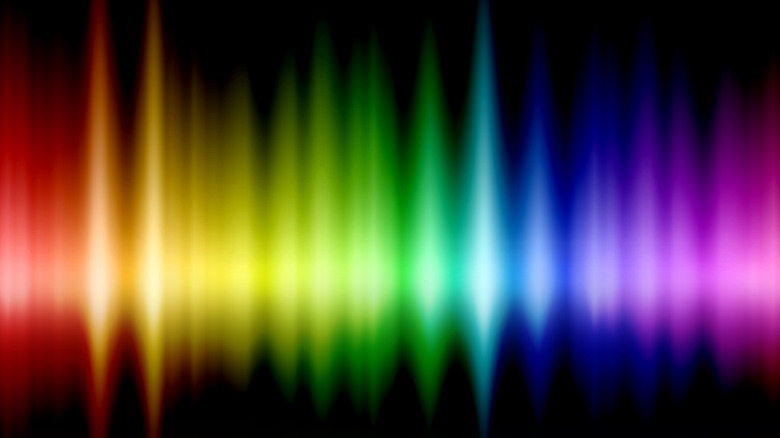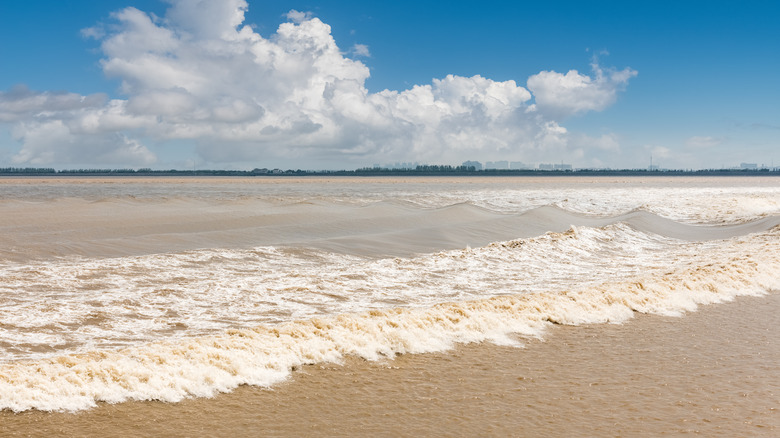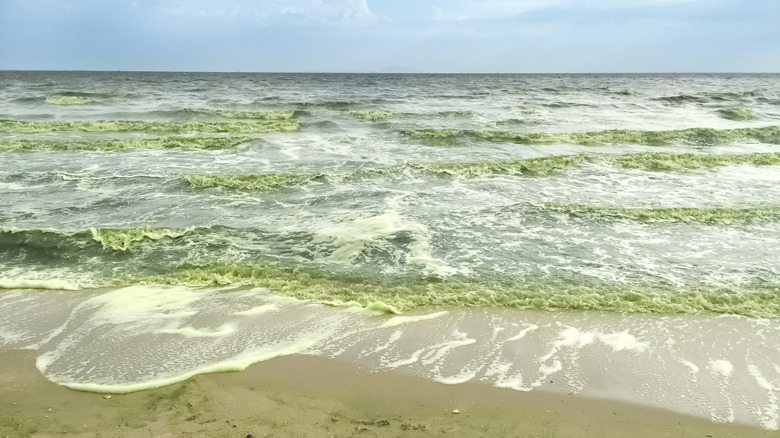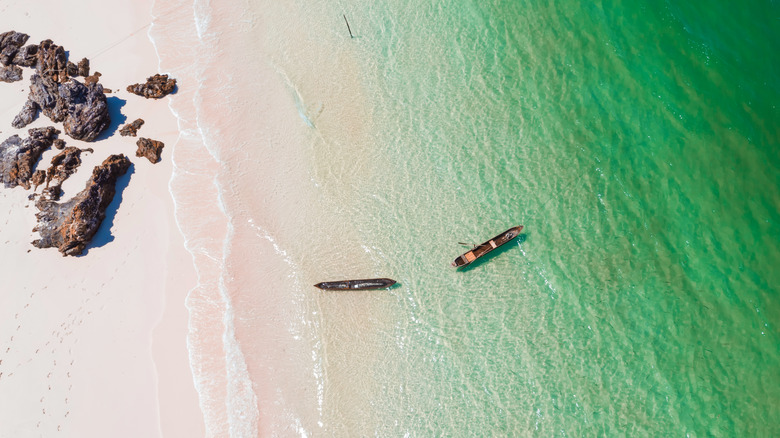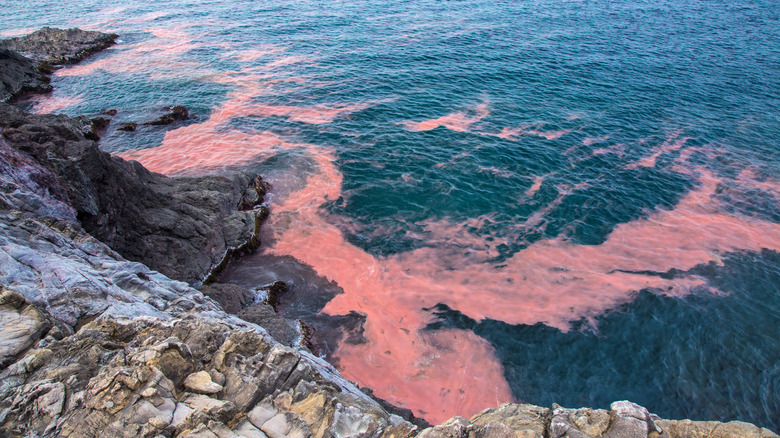The Scientific Reason Oceans Appear To Be Different Colors
We might know a lot about the land on Earth, but when it comes to the oceans, we don't know much. According to National Geographic, more than 80% of the ocean hasn't even been explored, much less mapped out. We don't even know how many species live there. But we do know that the Earth's surface is about 71% ocean. While all of the water on the surface of the Earth looks to be covered by one big ocean, it is divided up into the Atlantic, Pacific, Indian, Arctic, and Southern Oceans.
If you've ever looked at areal images of the Earth, you've no doubt noticed that the ocean isn't a single color, but a range of colors that include deep blue to green and all shades in between. Oceans can be other colors, too, and the color of an ocean can tell us quite a bit about what is going on in it.
Color wavelengths
We see single colors because they have different wavelengths. According to Woods Hole Oceanographic Institution, the color red has longer wavelengths, while shades of blue have the shortest wavelengths. When it comes to the ocean, water absorbs colors with long wavelengths first, which is why you won't see much red and yellow — especially in deeper areas. On the other hand, blue wavelengths permeate all of the ocean, including the deepest parts of it, which is why it's blue.
NASA explains that the ocean disperses blue lightwaves much like the sky does. The water also absorbs sunlight, which affects the color of the ocean. For instance, sunlight doesn't make it to the bottom of the deepest parts of the ocean, which is why those areas are the darkest blue. Elsewhere, sunlight is able to penetrate the more shallow areas, making them look light blue.
Sediment
The ocean consists of much more than water. Sediment floats in it, and sometimes it gets moved around. For example, runoff from rivers, storms, and waves change the way coastal regions appear. This movement results in a distribution of lightwaves that often make the water look brown (via NASA). In addition, the oceans are constantly moving, and as a result, they move heat around the surface area, pushing warmer water toward the poles. The wind makes most of this movement possible, but the Earth's rotation also contributes to the wind and flow of the currents, per National Geographic.
All of this movement pushes cold water from the bottom of the ocean to the top, creating an upwelling. Upwellings pull sediment from the bottom of the ocean, which also makes the water appear brown. NASA explains that the depth of the water also influences just how brown certain areas look.
Phytoplankton
Sediment isn't the only thing that gets stirred up when the oceans move — tiny organisms called phytoplankton are also affected by its currents. The Earth Observatory explains that most of these critters are single-celled organisms, but some are bacteria. They include diatoms, green algae, cyanobacteria, and coccolithophores. Depending on just what and how many of these organisms are in the ocean, the ocean can turn green, red, or brown. Satellite images show that they can even cause light turquoise swirls.
Phytoplankton need nutrients, carbon dioxide, and sunlight to survive in the ocean. Sometimes, they can experience a massive growth called a bloom. These blue-green spirals usually last a few days, but sometimes they can linger for weeks. The National Environmental Satellite, Data, and Information Service explains that phytoplankton blooms are common in the Barents Sea in late summer when the warm waters get 24 hours of sunlight.
Chlorophyll
Chlorophyll is present in all green plants, and they need it to undergo the process of photosynthesis. The plants in the ocean also produce chlorophyll, and phytoplanktons are responsible for most of the chlorophyll in the ocean. Ocean Tracks explains that chlorophyll absorbs red and blue light while reflecting green light. This phenomenon makes the ocean look many shades of green, and the amount of chlorophyll in the water determines how green it will appear.
Temperature is also a factor in how much chlorophyll will be in the ocean. Colder water tends to house more phytoplankton because it has the nutrients that they need to survive. Since more phytoplankton live in colder water, it will naturally appear greener because of the amount of chlorophyll it produces. In the same vein, warmer water has less phytoplankton, so it will appear bluer (via Ocean Tracks).
Other factors
The ocean needs to maintain a healthy balance of elements, and most of the time, nature has a way of working these things out. However, there are times when portions of the ocean become volatile. For example, the National Oceanic and Atmospheric Administration explains that too much nitrogen and phosphorus in the ocean triggers an overgrowth of algae, resulting in harmful algal blooms, or red tides. Red tides do exactly what you think they would — fill certain parts of the ocean with a red or pink tinge.
When algae grows too quickly in the ocean, it can also upset the natural balance, resulting in a lack of amount of oxygen in the water. This condition is called hypoxia, also known as a dead zone, a region in which nothing can live. These areas are generally a pale brown or greenish color. Live Science reports that nitrogen and phosphorous from fertilizer running into the ocean is the biggest source of dead zones in the U.S., with the largest dead zones being in the Gulf of Mexico and off the coast of Oregon.
